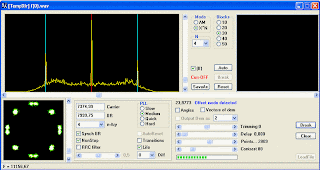We hope this will be useful...
It's a small fragment...
OQPSK and GMSK are tightly connected, as well as SDPSK and CPFSK, as well as pi/4 DQPSK and C4FM.
Such "dualism" is spread enough, and connected/linked by the fact that often some modes of frequency shift keying at some conditions, smoothly flowing and/or aspire to acquire the shape of phase manipulation.
*** GMSK ***
The general features of GMSK manipulation formation, we had already considered in the article FSK, GFSK, MSK, GMSK and some other modes . Also it was marked, that application of the filter of the Gauss allows to narrow the main spectrum of a signal considerably.
The filter of the Gauss is characterized by parameter BT, interested ones can independently learn this subject, us interested in the practical for the analysis moments.
The value range of parameter BT lies within 1 > BT > 0 limits. The lesser BT value, the more compact spectrum at resultant signal GMSK.
GMSK with the filter of the Gauss with BT = 1, is turning into classical MSK.
For formation of GSM signals the filter of the Gauss with BT = 0.3 is standardly used, and on an example of the synthesized signals it is possible to look as it looks from positions of tasks of the analysis.
Some preliminary remarks.
As, the finished result of concerning of GMSK nuances will be some conclusions about signal TETRAPOL
, then the synthesized signals have the same speed of manipulation equal 8000 Hz.
Besides, sometimes I will add a bit of white noise in the synthesized signals, because ideal signals though look beautifully, nevertheless, having absolute accuracy, in some cases these ideal signals conceal/hide the general details or make these details badly watched. This moment should be well clear from a picture below.
The full description here.


















